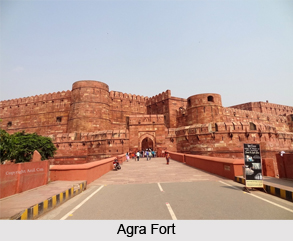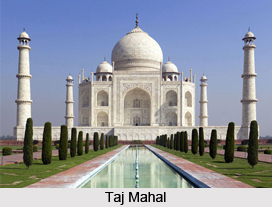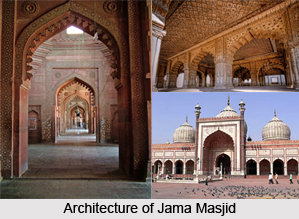 Agra, located on the banks of Yamuna River in the state of Uttar Pradesh, is popular for its monuments. Agra lies on the west bank of the Yamuna River above its confluence with the Ganges at Allahabad. The ancient history of the city is covered in darkness. This city attained fame from 1526 to 1658 as it became the capital city during the Mughal Empire. It is one of the renowned tourist destinations of India because of its several magnificent buildings and monuments of the Mughal period. Taj Mahal, one of the `Seven Wonders of the World` is at this city. Other very renowned historical monuments of this city are Agra Fort and Fatehpur Sikri. These three monuments are UNESCO World Heritage Sites.
Agra, located on the banks of Yamuna River in the state of Uttar Pradesh, is popular for its monuments. Agra lies on the west bank of the Yamuna River above its confluence with the Ganges at Allahabad. The ancient history of the city is covered in darkness. This city attained fame from 1526 to 1658 as it became the capital city during the Mughal Empire. It is one of the renowned tourist destinations of India because of its several magnificent buildings and monuments of the Mughal period. Taj Mahal, one of the `Seven Wonders of the World` is at this city. Other very renowned historical monuments of this city are Agra Fort and Fatehpur Sikri. These three monuments are UNESCO World Heritage Sites.
The superb Mughal monuments, for which Agra is popular throughout the world, made it an exceptional centre of civilisation, comparable in artistic preeminence to Rome. In addition to the unparalleled Taj Mahal, there are several forts, the fabled city of Fatehpur Sikri, the Tomb of Akbar at Sikandra and other splendid monuments. Akbar resided here in the early years of his reign and erected this Fort. His capital was at Fatehpur Sikri from 1571 to 1585 AD. But in the year 1599 he returned to Agra, where he died and was buried in the year 1605. It was Shah Jahan who did a lot to enrich the city with impressive monuments, conceived at the greatest point of Mughal architectural achievement. In the year 1761 Agra was sacked by the `Jats` under the Raja of Bharatpur and later on it was seized by the Marathas, and was ultimately captured by the British under in October 1803.
The Agra Fort dominates the centre of the city. Within its close proximity are some of the finest Mughal buildings of the country. The construction of this fort started in the year 1565, under Akbar, and it continued till the rule of Shah Jahan. It was constructed under the supervision of Muhammad Qasim Khan. It lies on the right bank of the Yamuna River near about 1 mile above the Taj Mahal. The Fort takes the shape of an irregular triangle with its base along the bank of the river. There are a total of four gates. The Amar Singh Gate to the south is actually the main doorway for the visitors. The Delhi Gate to the west and Water Gate to the east remain closed. Moreover, the fourth gate, to the north-east also remains closed. The exterior of the fort is built in red sandstone whereas the interior is patterned marble. The building is considered as the hallmark of the best Mughal architecture. It is a building of sublime simplicity and grace. 
The Tomb of Jangi Saiyid, which is said to predate the fort, is another attraction of this city. The Moti Masjid or Pearl Mosque, built by Shah Jahan stands at the highest point in the Fort. Akbar`s tomb at Sikandra portrays the wholeness of the personality of this popular Mughal Emperor. This tomb is vast and beautifully carved with red-ochre sandstone set amidst a green garden. It was Akbar, who himself planned his own tomb and selected an apposite site for it. The Turkic custom of constructing a tomb in one`s lifetime was religiously followed by the Mughal Emperors. Jahangir completed the construction of this pyramidal tomb in the year 1613. On this tomb, names of Gods from 99 different religious sects have been inscribed. Then again there is the `Gothic Christian tomb`. This is actually the grave of John Russell Colvin, Lieutenant-Governor of the North-West Provinces, who died at this place during the Mutiny of 1857. The `Nagina Masjid` or the Gem Mosque is another popular monument of this city. This beautiful white marble mosque with three domes was built by Shah Jahan.
One of the most famous buildings of the world is the Taj Mahal, the mausoleum of Mumtaz Mahal, Shah Jahan`s favourite wife. It is one among the World Heritage Sites of this city and also one of the `Seven Wonders of the World`. It was constructed by Shah Jahan as the final resting place for Mumtaz Mahal, his dearest wife. It was completed in the year 1653. This fascinating monument of India is built with white marble. It took 22 years for the completion of this building. It was designed by Persian architect Ustad Isa Khan Effendi and it is located on the banks of Yamuna River. When Shah Jahan was a prisoner of his son Aurangzeb, he used to gaze at this beautiful monument from the Red Fort.
Rabindranath Tagore defined Taj Mahal as `a tear on the face of eternity` whereas to others, it is `a tender elegy in marble` and the `ultimate expression of earthly love`. The Taj stands to the east of the Red Fort and is clearly visible from its ramparts. The surroundings of the Taj Mahal have been restored close to the original designs. The formal landscaping provides an apposite setting for this marvellous masterpiece of the Mughal era. The main entrance is from the west, but there are two other entrances - from the east and from the south too. The main gateway is a large, three-storey sandstone structure with an octagonal middle chamber with smaller two storey rooms to each side, covered by domed pavilions. Opposite is the Fatehpur Mosque, with a paved courtyard constructed in red sandstone. Immediately to the right, beyond the gate, is the Mausoleum of Sati-un-Nisa, Maid of Honour to Mumtaz Mahal and later governess to Princess Jahanara Begum, eldest daughter of Shah Jahan and Mumtaz Mahal. The message on the Queen`s tomb bears 99 names of `Allah` and the words.
Another splendid example of the Mughal architecture is the `Great Gateway` (1648), the grand portal to the Taj enclosure, faced in red sandstone. Next to the Great Gateway is a fine arcaded gallery of red sandstone. The view of the Taj from the Great Gateway is one of the most popular in the world, an inventive perspective carefully planned for maximum architectural impact. The stonework is inscribed with some passages from the Quran. The `Taj Museum` (1903) lies above and consists of a main hall and three side galleries. In the main hall, there are two fine marble columns that are believed to have come from the Red Fort. It also comprises portraits of Shah Jahan, Mumtaz Mahal and other Mughal emperors. Gallery I has various architectural drawings of the Taj. Gallery 2 exhibits porcelain and other instances of the detailed inlay work for which Agra is renowned. Gallery 3 has a wonderful collection of 17th-century Mughal coins and calligraphy.
On the left bank of the River Yamuna are three popular sites of interest. Near about 228 m north of the Jumna railway bridge is the Itmad- ud- Daula Tomb. This beautiful ornamented structure was constructed by Jahangir`s wife Noor Jahan. It was built as a memorial of Mirza Ghiyath Beg, Noor Jahan`s father in Agra. Before the establishment of the Taj Mahal, this tomb was the most popular structure in the city of Agra. It was built in the year 1628. The tomb is beautifully conceived, standing on a low platform. Sandstone corridor leads to the main tomb. The main tomb is constructed with the finest Indian marble embellished with mosaics and inlay work of semiprecious stones. The central chamber comprises the yellow marble tomb of Itmad-ud-Daula and his wife. The side rows are decorated with painted flowery decorations. The tomb is important as it signifies a change in the architectural pattern and style. However, the roof pavilion retains a distinctive Hindu feeling. The art of inlaying stone in marble had been practised for several years, but this was the first attempt to replicate Persian ceramic decoration and tiles work.
Other interesting and renowned monuments of the city of Agra are Swami Bagh Samadhi. This monument holds the ashes of Shri Shiv Dayal Singh Seth (Huzur Swamiji Maharaj). Its construction started in the year 1904. Mankameshwar Temple is another major place pf interest of Agra. It is one of the four ancient temples that are devoted to Lord Shiva. It is situated near the Jama Masjid. Another notable monument of this popular city is the `Jama Masjid`. This lavish mosque was attributed to Princess Jahanara Begum, Shah Jahan`s daughter. It was built in the year 1648. `Mariams Tomb`is the tomb of the wife of great Mughal Emperor Akbar, Mariam. On the east bank of the Yamuna River is the `Chini Ka Rauza` or Tiled Tomb, reputed to be the mausoleum of Afzal Khan, a Persian poet and later the prime Minister to Shah Jahan. It is an octagonal structure with a large bulbous dome. The central chamber of this monument contains the tombs of Afzal Khan and his wife.
Monuments of Agra define the changing patterns of the architectural style. They depict several unspoken stories of the past and of the exclusive Mughal era.



















